|
|
 |
|
 |
| |
Publisher: Chairman Gong-Ru Lin Editors: Professor
Chao-Hsin Wu, Ms. Hsiao-wen Lin September 30, 2013 |
| |
|
 |
|
Congratulations to Academician Chen-Shui Tsai on being awarded the 2013 IEEE-UFFC Society Achievement Award.
Congratulations to GIPO Professor Chi-Kuang Sun on being awarded the 2013 Outstanding Research Award of Pan Wen Yuan Foundation.
Congratulations to GIPO Ph. D. students Shih-Che Hung and Yu-Wen Wang, both representing EECS, on winning the championship of youth table tennis, NTU cup.
|
|
 |
|
 |
|
| |
|
 |
|
April
“Photonics Forum” Highlights
(Compiled by Li-Chi Yao) |
|
|
3:30 pm, Fri.,
April
26th, 2013 |
|
Speaker: |
Ms. Hui-Ju Chen (a scenarist and a writer) |
|
Topic: |
My life as a scenarist and a writer |
| |
Ms. Hui-Ju Chen visited GIPO on April 26th
(Fri.) and delivered a speech at lecture theatre 101, Barry Lam Hall. Ms. Chen is a master in social science of the University of Chicago, majoring in gender and culture identification studies. She was a senior reporter of Business Weekly’s “Alive” and a senior editor of “Mook”, a tour book, and is now a scenarist and a writer. Her works include: “Black & White”, a TV drama and a movie; “The Fierce Wife Final Episode”, a movie; “Chocolate”, a TV drama; “To hear I love you”, a movie winning the 2013 Excellent Script award. Her speech is mainly concerned the sharing of her experiences in growing up and its process. The content of the speech was exciting, and Ms. Chen interacted well with students. GIPO teachers and students took part in the event with enthusiasm and benefited greatly.
|
| |
|
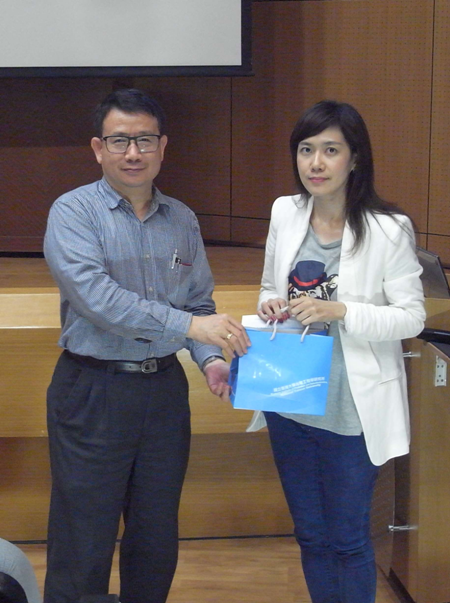 |
|
Ms. Hui-Ju Chen (right) and the host, GIPO chairman, Ching-Fuh Lin (left) |
|
|
May
“Photonics Forum” Highlights
(Compiled by Li-Chi Yao) |
|
|
3:30 pm, Fri.,
May
3rd, 2013 |
|
Speaker: |
Prof. Shangjr Gwo
(Dean, Office of Research and Development, National Tsing Hua University) |
|
Topic: |
Plasmonic Metamaterials and Nanolasers |
| |
Prof. Shangjr Gwo visited GIPO on May 3rd
(Fri.) and delivered a speech concerning “Plasmonic Metamaterials and Nanolasers” at lecture theatre 101, Barry Lam hall. His speech was rich and colorful in contents and the professor interacted very well with his audience. GIPO teachers and students participated in this event with enthusiasm and gained a lot from the experience.
|
|
|
|
|
|
3:30 pm, Fri.,
May
17th,
2013 |
|
Speaker: |
Prof. Lifeng Bian (Suzhou Institute of Nano-Tech and Nano-Bionics (SINANO), Chinese Academy of Sciences) |
|
Topic:
|
An introduction to
nano-devices and the major
application laboratories of the
Chinese Academy of Sciences |
|
|
4:30 pm,
Fri.,
May
17th,
2013 |
|
Speaker: |
Dr. Jianfeng Wang (a research fellow, Suzhou Institute of Nano-Tech and Nano-Bionics (SINANO), Chinese Academy of Sciences) |
|
Topic: |
HVPE growth of bulk GaN: stress, threading dislocation, and intrinsic properties of high-quality GaN |
| |
In answer to GIPO professor Zhe-Chuan Feng’s invitation, Prof. Lifeng Bian and research fellow Jianfeng Wang visited GIPO on May 17th
(Fri.) and delivered speeches concerning “An introduction to nano-devices and major application laboratories of the Chinese Academy of Sciences” and “HVPE growth of bulk GaN: stress, threading dislocation, and intrinsic properties of high-quality GaN” at room 205, Min-Da Hall. Their speeches were very exciting and both speakers interacted well with participating students. GIPO teachers and students attended this event fervently and gained a lot from it.
|
|
|
|
|
|
3:30 pm, Fri.,
May 24th, 2013 |
|
Speaker: |
Dr. Sin-Gi Chen (Deputy Chief, Taiwan Semiconductor Manufacturing Company Limited) |
|
Topic: |
The development of TSMC in the Southern Taiwan Science Park |
| |
Deputy Chief Sin-Gi Chen visited GIPO on May 24th
(Fri.) and delivered a speech concerning “The development of TSMC in the Southern Taiwan Science Park” at lecture theatre 101, Barry Lam hall. He introduced us to TSMC’s plan of overtaking Intel and becoming the world’s largest semiconductor manufacturer in the future. He especially focused his speech on the strategic status of STSP’s No.14 factory and the importance of 20nm to TSMC and Taiwan’s future. The speech was thought-provoking and exciting, and
Deputy Chief Chen interacted well with students. GIPO teachers and students took part with enthusiasm and learned a great deal.
|
| |
|
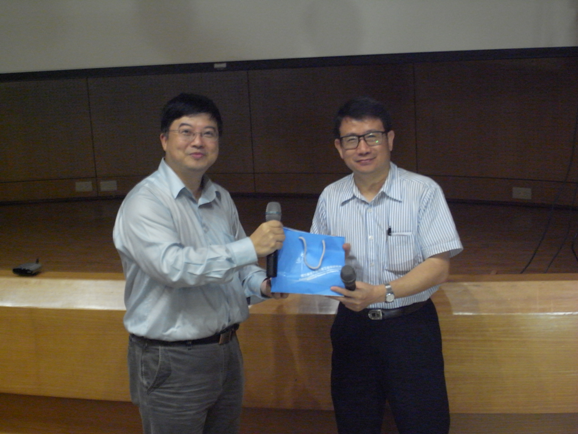 |
|
Deputy Chief Sin-Gi Chen (left) and GIPO chairman Ching-Fuh Lin (right) |
|
|
June
“Photonics Forum” Highlights
(Compiled by Li-Chi Yao) |
|
|
3:30 pm, Fri.,
June 7th, 2013 |
|
Speaker: |
Ms. Phoenix Chang (an actress and a writer) |
|
Topic: |
Passing through the space-time ~ a chat with myself of 20 years ago |
| |
Ms. Phoenix Chang visited GIPO on June 7th
(Fri.) and delivered the speech “Passing through the space-time ~ a chat with myself of 20 years ago” at lecture theatre 105, EE Building II. Her speech was fascinating, and Ms. Chang interacted well with participating students. GIPO teachers and students took part in this event with enthusiasm and learned a great deal.
|
| |
|
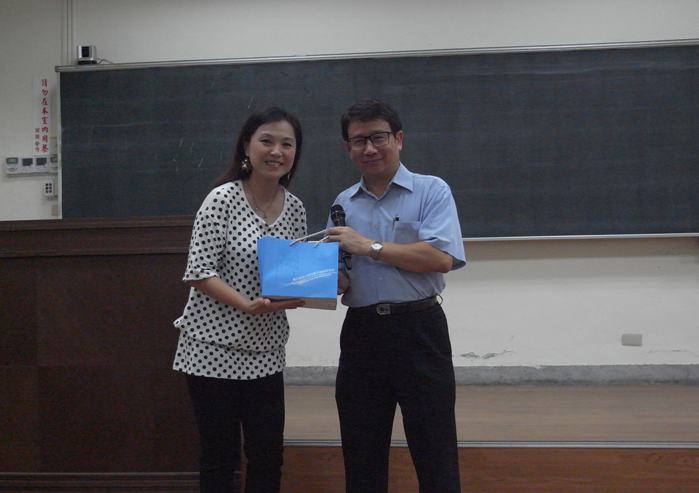 |
|
Ms. Phoenix Chang (left) and the host, GIPO chairman, Ching-Fuh Lin (right) |
|
~
Sidelights
on the GIPO Cup sports games, sponsored by GIPO
Student Association
~
(Time: May 11th,
2013; Location: Gymnasium, the
Gongguan Campus of National Taiwan Normal
University)
Compiled by Yi-Jiun Chen,
President of GIPO Student
Association
The GIPO Cup Sports Games, which always gets
our students up and moving, is here again. Due
to the limited availability of the gym this
year, we have no choice but to hold the games on
the day before Mother’s day. Moreover, because
of heavy rain during the day, we thought there
would be fewer students present. Much to our
surprise, a great number of students showed up.
(Please refer to photo 1.) Just as Chairman Lin
says, even the heavy rain could not dampen our
students’ passions.
|
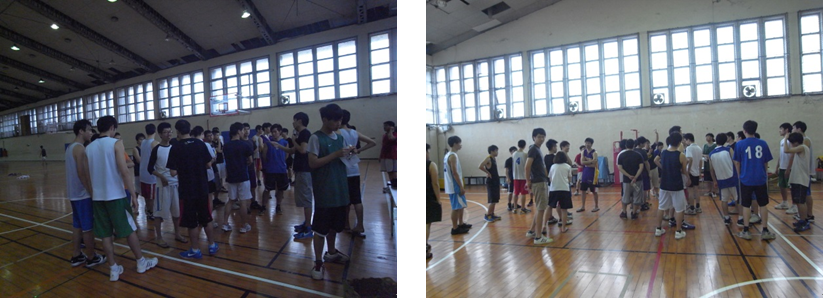 |
|
Photo 1: A spectacular view of students gathering in front of the registration stand. |
This year’s games adopted a point
accumulation system, different from the
previous years’. The points come mainly from
the 3-on-3 basketball game, played by teams
formed by individual laboratories. There is
also a new 10-on-10 dodge ball game, which is
also taken as a basis for point
accumulation. There is a penalty shot game
too, for individuals, during the
intermission of other games. And, at the end
of all scheduled games, there is a surprise
midfield free throw game for laboratories.
The details of all the games are as follows:
1. 3-on-3 basketball
There are 16 teams competing in this game;
therefore, the last 4 teams advancing to the
finals are very tough, especially when there
are school team members joining some teams.
The teams appeared deadlocked. (Please refer
to photo 2.) The following are the final 4
teams:
Prof. Jui-che Tsai’s laboratory (the 1st
place = accumulated points + 7)
Prof. Lon A. Wang’s laboratory (the 2nd
place = accumulated points + 3)
Prof. C. C. (Chih-Chung) Yang’s laboratory
(one of the final 4s = accumulated points +
1)
Prof. Chao-Hsin Wu’s laboratory (one of the
final 4s = accumulated points + 1)
|
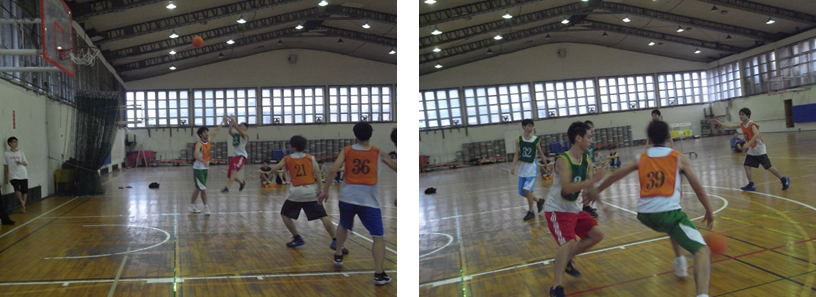 |
|
Photo 2: A scene from a fierce game at the basketball court. |
2. 10 vs.10 dodge ball
There are 6 laboratories registered for this
game, formed into 3 teams. At the beginning
of the game, perhaps because of having not
played it for too long, players appear very
courteous. However, after passing several
balls, our students seemed to have
remembered how they used to play when they
were children, and the situation on the
battlefield became intense. Although we
agreed beforehand not to hit faces1,
the passes got higher and higher during the
later stages of the game. This phenomenon
reveals that our students are usually under
a great deal of stress. (Please refer to
photo 3.)
The 1st match (3:0)
Prof. Jui-che Tsai + Prof. Hoang-Yan Lin’s
laboratories (3) : Prof. Lon A. Wang + Prof.
Chao-Hsin Wu’s laboratories (0)
The 2nd match (3:2)
Prof. C. C. (Chih-Chung) Yang + Prof.
Jian-Jang Huang2’s laboratories
(3) (the 1st place = accumulated points + 5)
: Prof. Jui-che Tsai + Prof. Hoang-Yan Lin’s
laboratories (2) (the 2nd place =
accumulated points + 3)
|
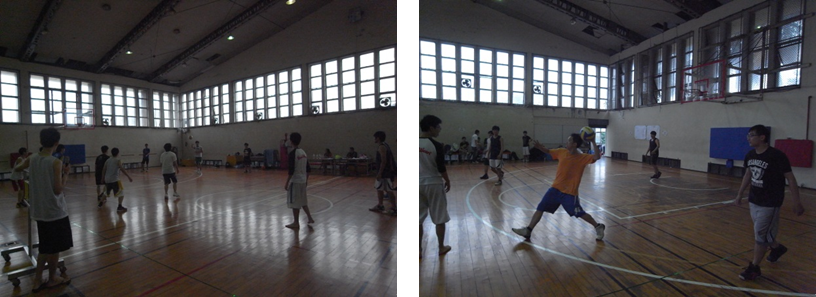 |
|
Photo 3: A scene from a fierce game at the dodge ball court3. |
Finally, the overall scores of this year’s
GIPO Cup Sports Games are as follows:
(please refer to photo 4.)
Prof. Jui-che Tsai’s laboratory (the
champion: 10 points)
Prof. C. C. (Chih-Chung) Yang’s laboratory
(the 1st runner-up: 6 points)
Prof. Jian-Jang Huang’s laboratory (the 2nd
runner-up: 5 points)
|
 |
|
Prof. Jui-che Tsai’s laboratory
(the champion: 10 points) |
Prof. C. C. (Chih-Chung) Yang’s laboratory
(the 1st runner-up: 6 points) |
|
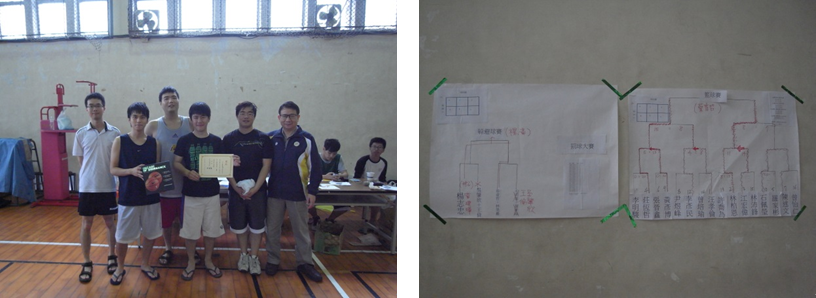 |
|
Prof. Jian-Jang Huang’s laboratory
(the 2nd runner-up: 5 points) |
A list of games’ results |
|
Photo 4: Prize-awarding ceremony & the results of the games. |
3. Penalty shot
In the preliminary round of the penalty shot
game, each player throws ten shots, and ten
best players will advance to the finals.
Nevertheless, if more than 10 players
qualify, i.e. several players have the same
score, all of them will advance. In the
finals, the one who throws in the most shots
in one minute will be the winner. And
finally Pei-Ying Shih, throwing in 17 shots
in one minute4, and winning great
admiration from the students present,
emerged as champion. (Please refer to photo
5.) (background music: “when the audience
clapped heartily …”, by Fei-Fei Fong)
|
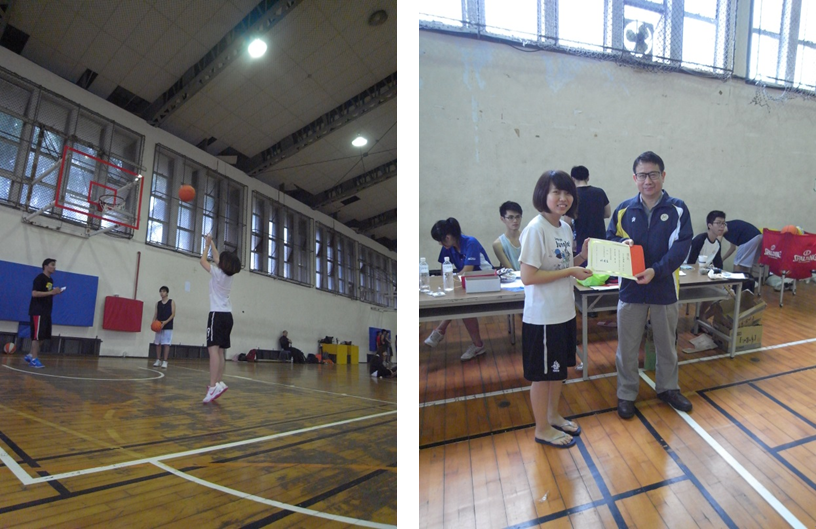 |
|
Photo 5: The champion of the penalty shot game |
4. Midfield free throw (each throws 3
shots)
In order
to let
those
who have
stayed
until
the last
have
some
prizes
to take
home, we
provided
an
additional
midfield
free
throw
contest.
And
afterwards
the team
of
professor
Chao-Hsin
Wu’s
laboratory
won the
game,
landing
2 shots
out of 3
by the
same
team
member.
(Please
refer to
photo
6.)
|
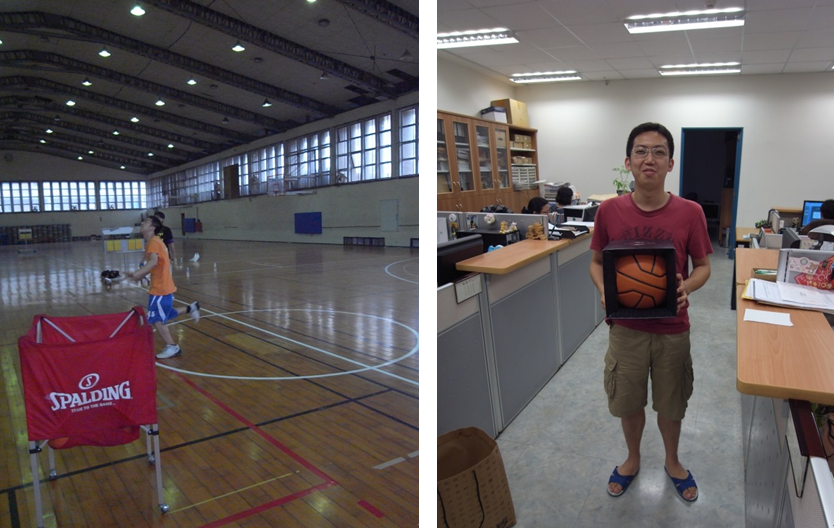 |
|
Photo 6: The champion of the midfield free throw game |
The spirit of this year’s GIPO Cup Sports Games is to emphasize the
interaction among laboratories; therefore, we created a new dodge ball
game rule of 2 laboratories forming a team to play against another two
laboratories. We hope to continue in this spirit in future games so
students of different laboratories can establish positive relationships
among themselves in study as well as in life. Finally, we wish to thank
Chairman Lin for awarding the prizes, and thank GIPO Student Association
members and GIPO office staff for their kind assistance, all of which
was crucial to the success of the games.
|
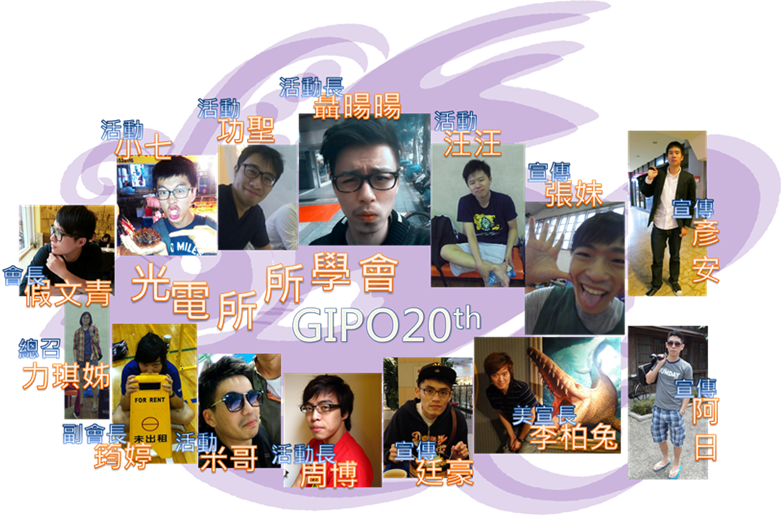 |
|
Photo 7: Members of GIPO Student Association |
1
The dodge ball game is formally named “the
10-on-10 dodge ball game of no hitting faces
as agreed”.
2
Chairman Lin
drew one as seed team.
3
Please refer to the following website for
relevant video:
https://www.space.ntu.edu.tw/navigate/s/502FEB3B691641769A30997618BA5D33QQY
4
The highest
score of male students is 13 shots per
minute.
|
 |
|
 |
|
| |
|
 |
Transient Behaviors of Current-injection
Quantum-dot Microdisk Lasers
Professor
Ming-Hua Mao's Laboratory
Graduate Institute of Photonics and
Optoelectronics, National Taiwan University
We studied the transient behaviors of
current-injection quantum-dot microdisk lasers at room temperature. Unique
optical responses were observed, including the suppression of relaxation
oscillations and fast turn-on. With the help of rate-equation modeling, the
suppressed relaxation oscillations are attributed to the enhanced spontaneous
emission factor in microdisk lasers. Short turn-on time, around 1 ns without
pre-bias, results from the reduced carrier lifetime caused by the Purcell effect
and increased nonradiative recombination rate due to higher surface/volume
ratio. With short turn-on time, a large-signal direct modulation experiment at 1
Gbps is demonstrated. Modal transient behavior was also investigated under
various temperatures from 100 to 300 K. Both of the transient lasing and steady
state lasing from side modes are suppressed at temperatures higher than 250K.
Therefore, the quantum-dot microdisk lasers show the potential of single-mode
operation under high-speed modulation at room temperature. This work has been
published in Opt. Express, Vol. 20, No. 3, pp. 3302, (2012).
|
 |
|
Figure 1. The temporal optical responses
measured from a QD microdisk laser. |
|
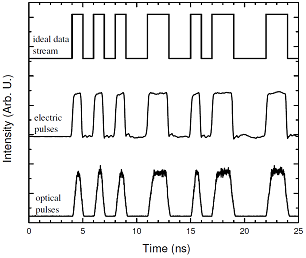 |
|
Figure 2. The ideal data stream at 1
Gbps, the real electric pulse shape, and
the optical responses of the QD
microdisk laser with pre-bias. |
Enhancing LED Light Extraction by Optimizing
Cavity and Waveguide Modes in Grating Structures
Professor
Yih-Peng Chiou's Laboratory
Graduate Institute of Photonics and
Optoelectronics, National Taiwan University
We provided an optimization of light extraction
efficiency (LEE) from light-emitting diodes (LEDs). The optimization is achieved
when the structural parameters results in good cavity modes in both planar and
grating structures, and also when the propagation direction of the fundamental
waveguide mode is significantly converted to the direction normal to the grating
surface by the gratings. In this research, we use two simple equations, one for
cavity modes and the other for waveguide modes, to predict the loci of the
optimal structural parameters of gratings. We first obtain the rules by
analyzing simple planar structures as illustrate in Fig. 1. (a). Fig. 1. (b)
shows the resonant condition by the micro-cavity effect. Fig. 1. (c) shows that
the local maximum LEEs appear periodically and are close to the cross of the
Fabry-Pérot resonances and the antinodes. The conditions of the resonance at
normal incidence and the anitnodes for normal waves are marked by the thick red
tics on the bottom and the thick black tics to the right, respectively. Even
with the optimization, the LEE of typical planar of LED can only reach up to
30%. To realize ultra-high LEE LED, the source is designed to locate close to
the middle of GaN cavity to concentrate the non-radiation power on the
fundamental mode and a periodic dielectric wavelength-scaled structure is etched
on the mesa surface of LEDs to convert the fundamental guided wave into air mode
as schematized in Fig. 2. (a). We modified the resonant condition of normal
incident case for grating-assisted system and gave the constructive interference
of the emitted waves:

From Fig. 2. (b-c), the local maxima of LEE appear near the
intersections of the two equations. The maximum LEE is close to 90% which is
triple of that of the planar surface LEDs. These results verified our
prediction.
 |
|
Fig. 1. (a) Scheme of optical modes in
in thin-film vertical LED. (b) Resonant
condition by the micro-cavity effect.
(c) Simulation results of LEE. Thick red
tics represent the thickness with
Fabry-Pérot resonance appearing at
normal incidence, and thick black tics
express as the antinode factors. |
 |
|
Fig. 2. (a) Propagation of waveguide
modes in a grating structure. (b-c)
Simulation results of the maximum LEE
for grating depth versus the GaN
thickness for duty circle=0.3 and 0.5. |
Reference: W.-L. Yeh, C.-M. Fang, and Y.-P.
Chiou, “Enhancing LED Light Extraction by
Optimizing Cavity and Waveguide Mode in Grating
Structures,” IEEE Journal of Display Technology,
Vol. 9, No. 5, pp. 359-364, May, 2013.
Simulating digitally manipulated light delivery
through turbid media
Professor
Snow H. Tseng's Laboratory
Graduate Institute of Photonics and
Optoelectronics, National Taiwan University
Digitally time-reversed ultrasound-encoded light
propagation through turbid media is simulated using numerical solutions of
Maxwell’s equations. A virtual light source embedded within a turbid medium is
modeled; specifically, we simulate the propagation of phase-conjugated light
through a turbid medium and homing in the virtual light source to form an
optical focus
within the turbid medium. The numerical simulations enable qualitative
and quantitative analysis of the effectiveness of directing light through turbid
media.
|
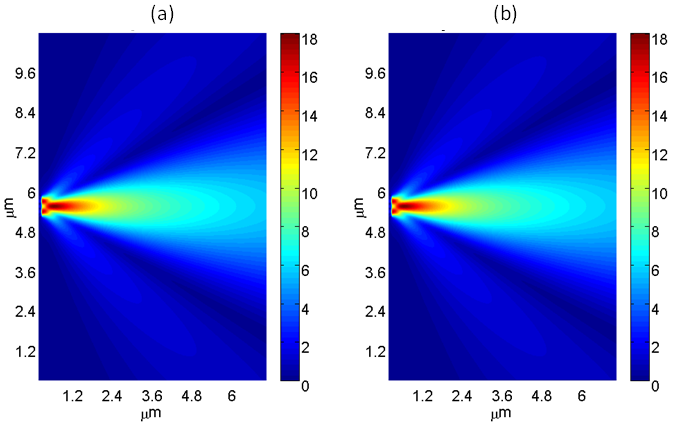 |
|
Fig. 1. Comparison of the incident light
and playback reconstructed light in
vacuum. The phasor profiles of the (a)
original illumination, and (b) the
phase-conjugated playback wave are
compared. Without scattering loss, the
original light profile is reconstructed
without observable difference. |
Fabrication of inkjet-printed SU-8 photoresist
microlenses using hydrophilic confinement
Professor
Guo-Dung J. Su's Laboratory
Graduate Institute of Photonics and
Optoelectronics, National Taiwan University
Microlens arrays are important components in many applications,
such as Shack-Hartmann wavefront sensors, beam shaping for illumination, light
gathering for solar concentrators and information displays, etc. Various
techniques to fabricate MLAs have been developed. Inkjet-printed microlens
arrays (MLAs) were fabricated using hydrophilic confinement by UV/ozone
treatment in the Micro Optics Device Lab of National Taiwan University. The MLAs
were made from negative photoresist SU-8 (n=1.63 at 530 nm). A film of
10-µm-thick SU-8 shadow mask was used to define UV/ozone-treated hydrophilic
zones on an SU-8 photoresist base layer. An inkjet print head was used to jet
SU-8 photoresist drops onto these zones. After UV-curing, MLAs with diameters of
150, 200, 400, 800 and 1000 µm were successfully fabricated. Contact angles of
MLAs increased from 22° (on MLAs fabricated using an SU-8 photoresist base layer
without any surface treatment) to 45.5°, 47.7°, 52.4°, 51.3° and 54.2°, for 150,
200, 400, 800 and 1000 µm lens diameters, respectively. Using hydrophilic
confinement, MLAs with a wide range of contact angles can be fabricated with
diameters from 150 µm to 1 mm. This method provides a simple, cost-effective
fabrication process without need for etch-transfer.
|
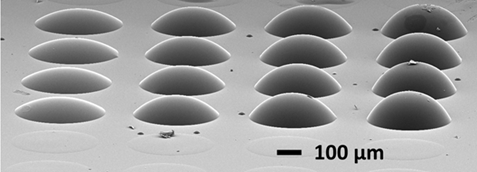 |
|
Fig. 1. MLAs of 400 µm diameter with 4
different contact angles: 29.7°, 39.6°,
47.3°, and 52.4°. |
Preparation of nanoporous TiO2 films
for DSSC application by a rapid atmospheric
pressure plasma jet sintering process
Professor
I-Chun Cheng
Graduate Institute of Photonics and
Optoelectronics, National Taiwan University
We investigate the nanoporous TiO2 films
sintered by atmospheric pressure plasma jets (APPJs) and their applications as
photoanodes of dye-sensitized solar cells (DSSCs). A 30-s APPJ-sintered
nanoporous TiO2 layer exhibits an additional absorption band between
400 and 500 nm in wavelength, attributed to incomplete removal of the organic
solvents in the pastes. For TiO2 layers sintered by APPJs for 60 s
and beyond, the absorption spectra are nearly identical to those of a
conventional 15 min, 510°C calcined sample. The XRD and XPS results indicate
similar characteristics for APPJ-sintered and furnace-sintered TiO2
films. A DSSC with a 30-s APPJ-sintered TiO2 photoanode shows poor
cell efficiency with an extremely large TiO2/dye/electrolyte electron
transport interfacial resistance and a short carrier lifetime (Figure 1). As the
APPJ treatment time reaches 60 s and beyond, the power conversion efficiencies
become comparable to that of a sample with a 510°C conventionally calcined TiO2
photoanode (Figure 2). Our experimental results verify that a 60-s APPJ
sintering process is sufficient to replace a conventional 15 min, 510°C furnace
calcination process for TiO2 photoanodes of DSSCs. The ultra-short
sintering process is made possible by the synergistic effect of the temperature
and the reactivity of the APPJ, which can lower the fabrication cost.
|
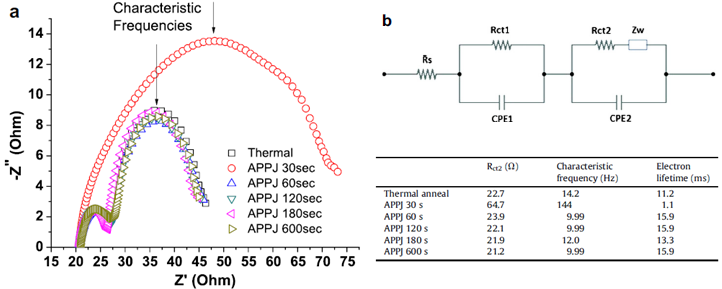 |
|
Figure 1. (a) Nyquist plot of DSSCs with photoanodes sintered by furnace and APPJ under illumination. (b) The model equivalent circuit diagram and the corresponding parameters. |
|
 |
|
Figure 2. (a) Typical IV characteristics and (b) power conversion efficiency of DSSCs with furnace-sintered and APPJ-sintered TiO2 photoanodes. |
©
2013 Elsevier B.V.
H. Cheng, Y.-J. Yang, H.-C Li,
C.-C. Hsu, I-C. Cheng, J.-Z. Chen, “Preparation
of nanoporous TiO2 films for DSSC
application by a rapid atmospheric pressure
plasma jet sintering process,” Journal of Power
Sources, vol. 234, pp. 16-22, 2013
MEMS doubly decoupled gyroscope with wide
driving frequency range
Professor
Jui-che Tsai
Graduate Institute of Photonics and
Optoelectronics, National Taiwan University
We developed a microelectromechanical systems (MEMS) doubly
decoupled gyroscope with a wide driving frequency range. The gyroscope (Fig. 1)
increases the resonance bandwidths of both the drive and sense oscillators
without sacrificing their Q factors. This bandwidth enhancement ensures good
frequency matching between the drive and sense oscillators even if fabrication
imperfections are present. Additionally, no in-operation frequency tuning
mechanism is needed. The gyroscope can be driven at any frequency within the
overlapping region of the resonance bands of the drive and sense oscillators.
Experiments showed that the gyroscope driving voltage can be of any frequency
within a ∼240-Hz bandwidth (Fig. 2). The wide bandwidth provides flexibility and
ease of use. The device’s doubly decoupled structure minimizes the
interference/coupling between the drive and sense units. Performance tests under
rotation rates equal to or smaller than 18.71 rad/s showed that the gyroscope
has a sensitivity of 4.28 mV/(rad/s).
|
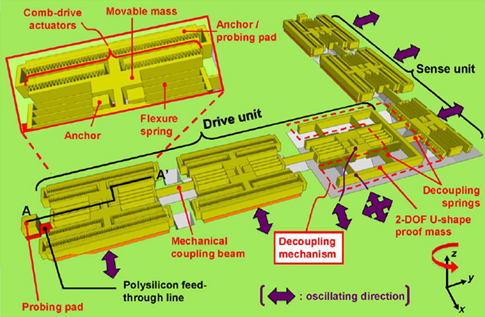 |
|
Figure 1 |
|
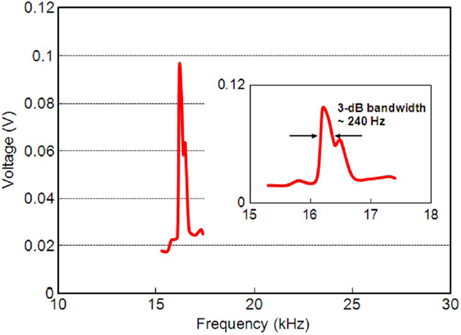 |
|
Figure 2 |
©
2012 IEEE
C. W. Tsai, K. H. Chen, C. K. Shen, and J. C. Tsai, “A MEMS doubly decoupled gyroscope with wide driving frequency range,”
IEEE Transactions on Industrial Electronics, vol. 59, no. 12, pp. 4921-4929, Dec. 2012.
|
|
|
 |
|
 |
|
| |
|
|
 |
|
 |
|
|
|